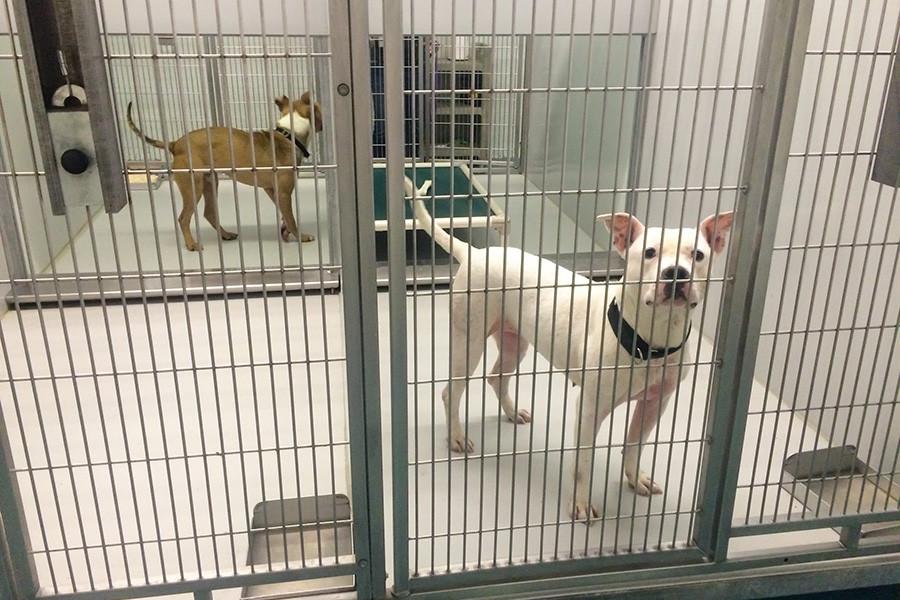After grant to fund animal shelter employees, city must amend proposed budget
Julia Jacobs/Daily Senior Staffer
After the Evanston Animal Shelter Association received a grant funding three part-time employees to manage the shelter and kennel, city officials must alter the proposed budget released one week ago. This month, EASA established financial independence from the city to run the shelter.
October 15, 2015
One week after releasing the proposed Evanston budget, city officials already have plans to revise it after aldermen voted Monday to fund three part-time employees for the Evanston Animal Shelter Association.
The proposed budget, which the city released Friday, included $1.5 million worth of potential reductions to implement in case the state’s eventual budget includes cuts to local government funding. Part of those cuts included the elimination of the chief animal warden position, which would save the city $97,000, as well as the city’s $50,000 payment to the Evanston Animal Shelter Association as part of the new staffing agreement.
Three days later, City Council voted unanimously to grant EASA funding to hire three part-time employees to manage the shelter and maintain its kennel for a total of $65,000 per year until the non-profit’s contract expires in May 2017.
City manager Wally Bobkiewicz said the two lines of the potential reductions would have to be amended to reflect the council’s latest action. However, the city will still save some money because it contracted out all adoption and shelter maintenance work to EASA, leaving no city staff members working in the shelter, he said. Those savings — amounting to about $35,000 — would replace the two potential reductions released Friday, he added.
During the year in which the city managed the shelter after the departure of the non-profit Community Animal Rescue Effort, there were two full-time and one part-time city employees working in both animal control and at the animal shelter: a chief animal warden, a deputy animal warden and a part-time position for kennel maintenance, Bobkiewicz said.
Now that EASA is officially running and fundraising for the shelter, there will only be one animal warden working within the police department who is devoted to typical animal control duties, such as a storing dead animals found on the street. The city transferred all shelter responsibilities to the three part-time EASA employees, saving the city money on overhead costs such as benefits, Ald. Jane Grover (7th) said.
Grover said it has been a long-term goal of the council to shift shelter management from the city to the volunteer animal organization that runs the shelter — now managed by EASA.
After CARE was ousted from the shelter in May 2014 largely due to its canine euthanasia rate, the city took over full operation of the shelter with the help of volunteers. One year later, management passed to EASA, but the organization only established financial independence from the city this month.
In addition to the grant to fund three EASA employees, the council passed a new animal welfare policy that specified protocol for making decisions to euthanize dogs based on behavioral problems.
“Before, there was no policy that established that this was a no-kill shelter,” Grover said.
Vicky Pasenko, a former CARE volunteer who co-founded EASA, told The Daily earlier this week that plans for a new euthanasia policy have been in the works since CARE’s departure. The policy requires the shelter to maintain a live-release rate of 90 percent or else be under the review of the American Society for the Prevention of Cruelty to Animals.
Decisions to euthanize must go through the city’s Animal Welfare Board, a veterinarian and the animal warden.
“It’s kind of like the separation of powers in the government,” Pasenko said. “There are a number of people and a number of options that have to be carried about before the euthanasia can take place.”
Bobkiewicz said the council’s latest actions were a success in recognizing and acting on the challenges the shelter has faced in the past few years.
“It’s nice when we actually get to end those processes and clean those things up — I wish we could do that every day,” he said. “It is one of those instances in which policy direction has been implemented and comes full circle.”
Email: [email protected]
Twitter: @juliarebeccaj


